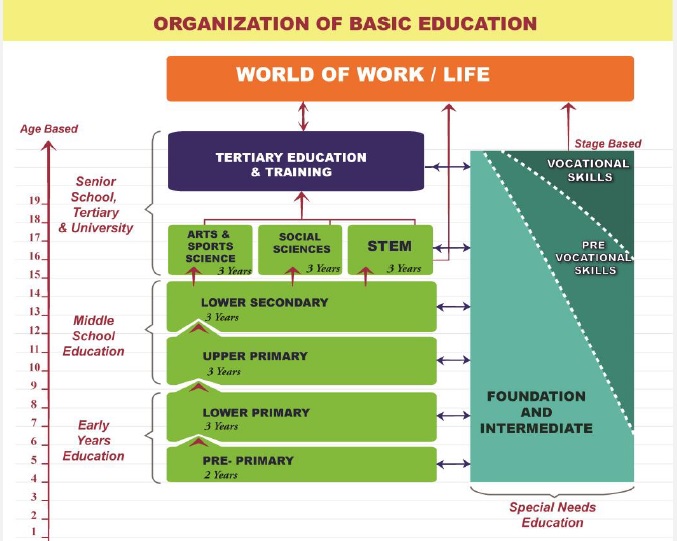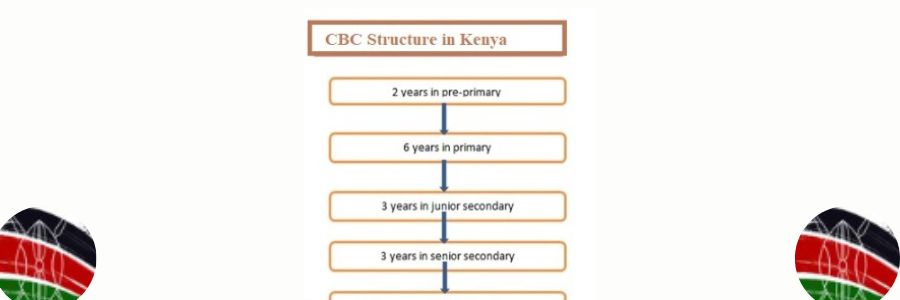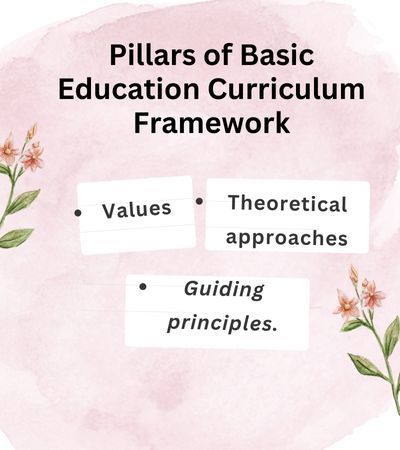Contents
CBC Curriculum Structure: CBC stands for Competency-Based Curriculum and CBC Curriculum Structure framework commenced in January 2018. However, the idea was introduced by an education committee led by Professor Odhiambo, which came up with The Sessional Paper No. 2 of 2015 on “Reforming Education and Training in Kenya‟. Sessional Paper No. 2 of 2015 recommended a Competency-Based Curriculum {CBC}; that would
develop learners’ potential in a holistic and integrated manner, while producing intellectually, emotionally, and physically balanced citizens.
CBC Curriculum Structure.
The current education system in Kenya has adopted the CBC curriculum where pre-school will be 2 years, 6 years in primary, 3 years in junior secondary, 3 years in senior secondary, and finally at least 3 years in university.

Importance of CBC curriculum.
- To allow all Kenyan students to become more engaged and empowered by the education.
- Provide high-class standards skills and knowledge to students.
- To enable the delivery of excellent teaching, school environments, and resources that will lead to practical skills.
- To have a sustainable visionary curriculum that provides every learner with excellent skills and competency that adds value to every learner.
- Basic Education will be organized into three (3) levels: Early Years Education, Middle School Education, and Senior School.
Read: CBC Grade 6 Timetable 2023 – CBC Grade 6 Exams 2023 Timetable
Differences between the 8.4.4 system and the CBC Curriculum system?
| 8-4-4 System. | CBC System. | |
| 1. | 8 years in primary school. | 6 years in primary. |
| 2. | 4 years in secondary school. | 6 years in secondary school. |
| 3. | 4 years in university. | 3 years in university. |
| 4. | Has national exams. | No national exams. |
| 5. | Exam-oriented. | Practical oriented. |
| 6. | Less inclusive for parents. | More inclusive for parents. |
CBC Curriculum Subjects in Kenya
1) CBC PP1 and PP2 subjects in Kenya.
Shall include two years of pre-primary.
Children will mostly learn from activities other than theory. They will also be engaged in digital literacy and they cover the content in the following subjects.
- Environmental Activities
- Language Activities
- Psychomotor and Creative Activities
- Mathematical Activities
- Religious Education Activities
Read: KCSE Timetable
2) CBC Grade 1,2 and 3 subjects in Kenya.
After two years in pre-primary, learners will join lower primary. This will include grade 1, grade 2, and grade3. The minimum age to join grade one is 6 years.
- ICT will be integrated at all levels and in all subjects. Emerging and contemporary issues will also be integrated.
- Mathematical Activities.
- Literacy.
- English Language Activities.
- Hygiene and Nutrition Activities.
- Kiswahili Language Activities/Kenya Sign Language for learners who are deaf.
- Indigenous Language Activities.
- Religious Education Activities.
- Environmental Activities.
- Movement and Creative Activities.
Read: CBC Junior Secondary Subjects
3) CBC Grade 4,5 and 6 subjects in Kenya.
Three years after Lower Primary learners will join upper primary as part of middle school. This will include grade 4, grade 5, and grade 6. At this level, learners will have a broad curriculum and they will be given an opportunity for experimentation & exploration.
In addition to the integration of ICT in the subjects, learners will also have a pastoral program which will be conducted once per week.
- English.
- Agriculture.
- Social Studies.
- Kiswahili or Kenya Sign Language (for learners who are deaf).
- Home Science.
- Mathematics.
- Science and Technology.
- Kiswahili or Kenya Sign Language (for learners who are deaf).
- Physical and Health Education.
- Religious Education (IRE/CRE/HRE).
- Creative Arts.
- Optional subject-Foreign Languages (Arabic, French, German, Mandarin).
Read: Top 10 Universities in East Africa
4) CBC Grade 7,8 and 9 subjects in Kenya.
Unlike the old 8-4-4 system which has form one to form four, the new 2-6-6-3 education curriculum will have lower secondary that will take 3 years. This will include grade7, grade 8, and grade 9. Lower secondary will expose the students to a wide-based curriculum to allow them to discover their own capabilities, character, and potential. Learners will choose subjects as per their interests and career paths as they join senior secondary. At this level, learners will also be involved in career guidance to enable them to make informed career decisions as they prepare to join senior secondary.
Core Subjects
Learners will be obligated to take the twelve core subjects as indicated below.
- Mathematics.
- English.
- Kiswahili or Kenyan Sign Language for learners who are deaf.
- Pre-Technical and Pre-Career Education.
- Integrated Science.
- Social Studies.
- Agriculture.
- Religious Education – learners choose one of the following:
i) Christian Religious Education.
ii) Islamic Religious Education.
iii) Hindu Religious Education.
- Health Education.
- Life Skills Education.
- Sports and Physical Education.
- Business Studies.
Read: KCSE CV Writing Format
Optional Subjects
Learners are given chance to select a minimum of one and a maximum of two subjects according to character, skills, interests, and career selections from the list below.
- Visual Arts.
- Home Science.
- Performing Arts.
- Computer Science.
- Foreign Languages:
- French.
- German.
- Arabic.
- Mandarin.
- Kenyan Sign Language.
- Indigenous Languages.
Read: How to Apply For Birth Certificate Online In Kenya
5) CBC Grade 10,11 and 12 subjects in Kenya.
This level will include grade10, grade 11, and grade 12. Students in these grades will mostly be between 15 to 17 years. It will give training that will lay the foundation for further education at the higher level. The senior secondary will mark the close of Basic Education. At the end of this level, learners are expected to be “empowered and principled citizens” who are prepared to contribute to the socio-economic growth of the nation.
As they enter senior secondary learners will have had the chance at lower secondary to explore their abilities and hence will be ready to specialize in their own career path. This means that they will choose studies in Social science, Art and Sports science or Science, Technical, Engineering, and Mathematics.
Another interesting thing about the CBC Curriculum Structure is that Schools will be specialized institutions that will give opportunities to learners to engage in a field of their own choice. In addition, they will form a good basis for higher education and training. Learners will gain skills and abilities that will make and improve employable skills.
As a result of the responsibilities laid upon the senior secondary, they will be required to therefore organize open days. These open days will ensure that learners and parents collect the information essential for appropriate decision-making. Moreover, a vigorous parental empowerment and involvement program will be needed to reinforce the support of parents in this process.
Read: Debate Motions for Secondary Schools in Kenya
Subjects to be taught in new 2-6-6-3 education curriculum in the three years of senior secondary
Since senior schools are expected to make informed choices in respect to their career, the schools will therefore offer training based on the vital infrastructure that would safeguard the growth of the capabilities identified in that career pathway.
The 3 career pathways are:
(1) Arts and Sports Science.
(2) Science, Technology, Engineering and Mathematics (STEM).
(3) Social Sciences.
Senior secondary schools will also decide to offer one or more pathways depending on the resources to get the needed infrastructure.
Education for Learners with Special Educational Needs.
Learners with special needs in the below-listed category and have the capabilities will follow the normal curriculum as the rest of the students. These learners will include those that have.
- Emotional and Behavioral Difficulties.
- Visual Impairment.
- Autism.
- Physical Handicap.
- Hearing Impairment.
- Learning Disabilities.
- Mild Cerebral Palsy.
- Communication Disorders and the
- Gifted and Talented.
Pillars of Basic Education Curriculum Framework
They include
- Values
- Theoretical approaches
- Guiding principles.
Core Competencies in CBC
CBC Framework seeks to develop these competencies so that all Kenyans can thrive in the 21st century.
1. Communication and Collaboration
2. Self-efficacy
3. Critical Thinking and Problem Solving
4. Creativity and Imagination
5. Citizenship
6. Digital Literacy
7. Learning to Learn
What is Competency-Based Curriculum in Kenya?
According to UNESCO, a Competency-Based Curriculum is an education system that puts emphasis on the many-sided results of a learning process. In other words, it impacts learners’ knowledge, skills, and attitudes. Compared to other education systems that mainly focus on what learners are anticipated to learn, CBC is learner-centered and is flexible to the changing needs of students. Learning is built in a way that learners are able to acquire and apply their knowledge, and skills in a day-to-day situation.
Conclusion: CBC Curriculum Structure
Kenya Institute of Curriculum Development developed CBC Curriculum Structure to change the 8-4-4 system that has followed since 1985. 8-4-4 system has been extensively criticized for being too broad in terms of content and being overly exam-oriented. As result the system had put too much unnecessary pressure on learners. The CBC- Competency-Based Curriculum will enable learners’ grow mental ability to handle issues and problems that cultivates capabilities of learners founded on their desires and gifts. In addition, it puts emphasis on Continuous Assessment Tests (CATs) over one-time examinations like the KCSE and KCPE.

Betty is a qualified teacher with a Bachelor of Education (Arts). In addition, she is a registered Certified Public Accountant. She has been teaching and offering part-time accounting services for the last 10 years. She is passionate about education, accounting, writing, and traveling.

